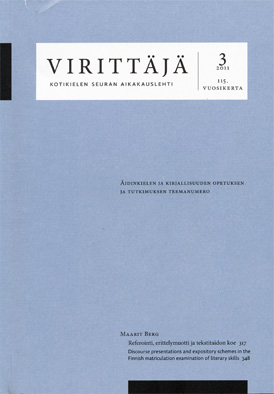Referointi, erittelymuotti ja tekstitaidon koe [Discourse presentations and expository schemes in the Finnish matriculation examination of literary skills]
Abstrakti
Artikkeli perustuu tutkimukseen referoinnin muodoista ja merkityksestä äidinkielen ja kirjallisuuden ylioppilaskokeen ensimmäisessä osassa, tekstitaidon kokeessa. Tekstitaidon kokeessa kokelaan on tarkoitus koevastauksessaan eritellä ja tulkita ns. aineistotekstiä tehtävänannon mukaisesti. Tämän tutkimuksen aineistossa ei ole mukana kaunokirjallisiin aineistoteksteihin perustuvia koevastauksia vaan artikkelissa tarkastellaan kahden asiatekstin, koevastauksen ja aineistotekstin välistä suhdetta referoinnin kautta.
Tutkimuksen lähtökohtana on tarkastella, miten Isossa suomen kieliopissa (ISK 2004) kuvatut referoinnin kategoriat, suora ja epäsuora esitys sekä vapaa suora ja vapaa epäsuora esitys, toimivat kokelaiden tekstissä. Osoittautuu, että vapaan ja suoran kategoriat eivät aineiston perusteella ole ongelmattomasti yhdistettävissä. Erityisen kuvauksen ongelman muodostaa yhden sanan mittainen sitaatti, kuten virkkeessä Kirjoittaja väittää, että sudet on ”demonisoitu”. Sitaatti on vain lainausmerkkien perusteella suoraa esitystä, vaikka välimerkkien kieliopillista merkitystä ei ole ISK:ssa kuvattu.
Lisäksi suora esitys on osa lausetta, joka on epäsuoraa esitystä. Referoinnin eri muotojen suhde toisiinsa on kiinnostava mutta pitkälti avoimeksi jäänyt kysymys. Tässä artikkelissa kuvataan referoivien lauseiden suhdetta toisiinsa monilauseisissa referointijaksoissa. Suhteita kuvataan retorisen rakenteen teorian tarjoamin luokituksin.
Tutkimus esittää uutta referoinnin kategoriaa, upotettua referaattia. Sen merkitys tekstitaidon kokeessa on perustella tulkintaa tutkimuksessa löydetyssä ns. erittelymuotissa, jota artikkelissa myös lyhyesti kuvataan.
---
Discourse presentations and expository schemes in the Finnish matriculation examination of literary skills
The article analyses the uses of discourse presentations in the Finnish matriculation examination of literacy skills. The data consists of hand-written texts of 1–4 pages each produced at the matriculation examination and provided for analysis by Ylioppilastutkintolautakunta (the Matriculation Examination Board). In their texts, matriculation candidates (aged 18–19) are expected to analyse either argumentation in one so-called data text or rhetorical devices in another data text.
The categories of the discourse presentation used are those of Iso suomen kielioppi (‘Big Finnish Grammar’, 2004), namely direct speech (‘speech’ includes writing and thought), indirect speech, free direct speech and free indirect speech. An empirical analysis of the data shows that the combination of the categories ‘free’ and ‘(in)direct’ is problematic, especially when the candidate quotes one word from the data text and embeds it into his/her own sentence, e.g. The writer claims that wolves have been “demonised”. The quoted word is direct speech on the basis of the quotation marks alone, even though grammars do not describe the meaning of the punctuation.
Moreover, the quote is part of another clause, namely indirect writing presentation. How different discourse presentations within the same sentence are related to one another is an interesting yet open question. The candidates’ texts also include long indirect presentation chunks consisting of several sentences. These can also be seen as hierarchically structured wholes in which discourse presentations form nucleus-satellite relations. Here the article applies Rhetorical Structure Theory to the data.
The article suggests a new category, an embedded quote, and reflects upon its place within the conventional system. It shows the meaning of the quote as part of a structure that the writer of this article calls an ‘expository structure’. This structure is very typical of the genre, and the function of discourse presentation as a part of the structure is that of giving evidence to the interpretation. Expository discourse is a central part of the school of discourse that can be described as ‘elaborative’, to use Bernstein’s term.






